European Neighbourhood Policy - South - economic statistics
Data extracted in March 2023.
Planned article update: April 2024.
Highlights
Israel is the only European Neighbourhood Policy-South country to record GDP per inhabitant that is above the average level for the EU (Israel latest available data 2019; EU data 2021).
Among the European Neighbourhood Policy-South countries for which recent consumer price (CPI) data are available, Algeria had the highest inflation in both 2021 (7.2 %) and 2022 (9.6 %). However, Lebanon reported an inflation rate of 84.9 % for 2020.
In recent years, among the European Neighbourhood Policy-South countries, Israel has had the most positive balance of payments current account (4.6 % of GDP in 2021) and Lebanon has had the largest deficit (-21.2 % of GDP for 2019, the most recent data available).
Real GDP growth, 2011-2022 (% change compared with previous year)
This article is part of an online publication. It provides data on economic statistics for nine of the countries that form the European Neighbourhood Policy-South (ENP-South) region —Algeria, Egypt, Israel, Jordan, Lebanon, Libya, Morocco, Palestine [1] and Tunisia; no recent data are available for Syria.
The article presents, among others, statistics on gross domestic product (GDP); GDP by expenditure components; gross value added at basic prices by economic sector; the index of consumer prices; the external balance of payments; and foreign direct investment (FDI).
Full article
Gross domestic product
Gross domestic product (GDP) is an aggregate measure of the size of an economy, based on its total output.
Figure 1 shows GDP data for 2021 or the most recent data available. This data illustrates the relative sizes of the economies of the European Neighbourhood Policy–South countries. For comparison, the GDP of the EU in the same year was €14 531 billion.
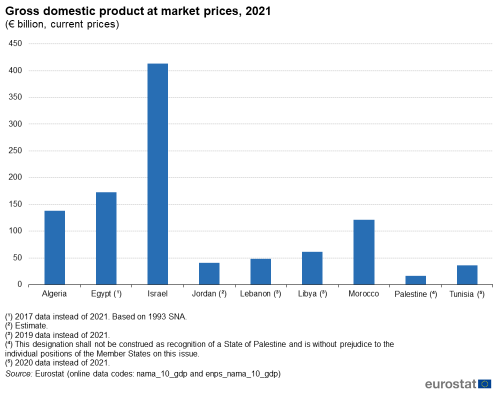
(€ billion, current prices)
Source: Eurostat (nama_10_gdp) and (enps_nama_10_gdp)
Real or constant price GDP focuses on the volume of output, ignoring price changes. The calculation of the annual growth rate of GDP at constant prices, in other words the real change in GDP, allows comparison of the dynamics of economic development, both over time and between economies of different sizes, regardless of price developments. Growth rates in constant price GDP are shown in Table 1 for ENP-South countries and the EU for the period 2011-2022, or the most recent data available.
Average annual growth in real GDP among the ENP-South countries over the period 2011-2019, before the Covid-19 pandemic, ranged from 4.1 % in Palestine and 4.0 % in Israel to 0.4 % in Lebanon. In Palestine, the average over this period was influenced by strong growth in 2011 and 2016 and a recession in 2014. Slower growth was recorded for Palestine from 2017 to 2019. A major recession in 2019 (-7.2 %) pulled down the Lebanese average for the period 2011-2019. Growth in Israel was more consistent over this period.
GDP growth in Algeria over 2011-2019 averaged 2.6 %, but growth slowed during 2017-2019 compared with 2011-2016. In Morocco, annual growth 2015-2019 (no data for prior years) averaged 3.2 %, pulled down by low growth in 2016. Egypt’s annual average growth rate over 2011-2017 (no data for 2012 nor for the years after 2017), was 3.3 %. Growth was higher during the years 2015-2017 than in the earlier part of this period.
The annual average growth rate for Jordan over 2011-2019 was 2.4 %. For Tunisia (no data for 2015), it was 1.7 %. The data for Libya is difficult to interpret for individual years. However, the annual average growth in GDP over the period 2011-2019 was at 1.8 %.
In the EU, annual average growth in constant price GDP over 2011-2019 was 1.5 %, with growth picking up at EU level during the period 2014-2019, notably with growth of 2.8 % in 2017.
GDP growth in the years 2020 and 2021 was strongly influenced by the effects of the Covid-19 pandemic in all ENP-South economies for which data is available and in the EU. All economies showed negative growth, a recession, in 2020. This was followed in 2021 by a recovery, in each economy with growth higher than its average for the period 2011-2019.
The steepest recession was estimated in Palestine, with GDP shrinking by -11.3 % in 2020, followed by a strong recovery of 7.1 % in 2021. The most recent estimate for 2022 is for growth of 2.5 %. Israel’s 2020 recession was the mildest among the reporting ENP-South economies, with GDP declining by -1.9 %. Israel’s 2021 growth was 8.6 %, the highest among the reported data. The 2020 decline in the EU was -5.6 % and growth in 2021 was 5.4 %. Its 2022 GDP growth data is 3.5 %.
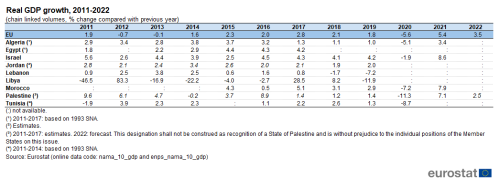
(chain linked volumes, % change compared with previous year)
Source: Eurostat (nama_10_gdp) and (enps_nama_10_gdp)
An analysis of GDP per capita (i.e., per inhabitant) removes the influence of the absolute size of the population, making comparisons between countries of different sizes easier. GDP per capita is therefore a broad economic indicator that may be used for a basic analysis of average living standards. In this article, it is measured using real GDP to remove the effects of changes in prices, as explained above. Nevertheless, differences in national accounts compilation methods may affect comparisons among ENP-South economies. Real GDP per capita based on constant 2015 prices is illustrated in Figure 2 for each of the ENP-South countries for which data are available.
In 2021, Israel’s real GDP per capita in 2015 prices corresponded to about €37 100, higher than the EU average of €29 800. The other ENP-South countries recorded much lower levels in 2021 (or for the most recent year available). Libya’s real GDP per capita was €7 800 and that of Jordan €3 600, both in 2019. Algeria (2021 data) had a real GDP per capita of €3 500, Tunisia (2020 data) €3 400 and Egypt (2017 data) €3 300. Morocco’s real GDP per capita in 2021 was €3 100 and that of Palestine estimated at €2 700 (also 2021).
Looking at ‘real’ changes in per capita GDP over the time period for which data is available, as measured in constant 2015 prices, the largest gain was in Libya, where GDP per capita in constant prices increased by an annual average of 17.9 % over the period 2011-2019. However, this calculation is strongly affected by the low GDP in 2011 during the civil war in the country. Israel also recorded strong growth in real GDP per capita over 2011-2021, by an annual average of 1.8 %. Morocco and Egypt also had increases in real GDP over the available periods, by annual averages of 1.2 % (2014-2021) and 0.5 % (2012-2017), respectively. In contrast, per capita change in GDP in constant prices was slightly negative in both Algeria and Palestine over 2011-2021, both at -0.2 % per year. It was more negative in Tunisia, at an annual average of -1.4 % over 2015-2020. Jordan’s real GDP per capita declined at an annual average rate of -3.2 % over the period 2011-2019.
The annual average per capita growth in GDP in the EU, measured in 2015 constant prices, was 1.0 % over 2011-2021.
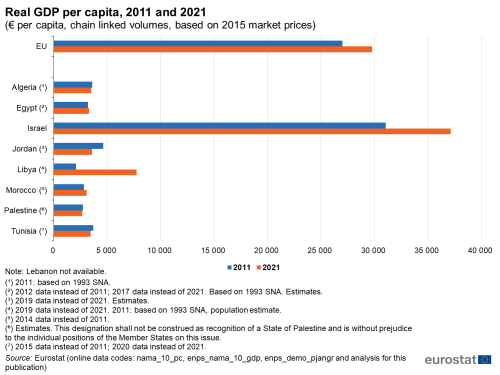
(€ per capita, chain linked volumes, based on 2015 market prices)
Source: Eurostat (nama_10_pc), (enps_nama_10_gdp), (enps_demo_pjangr) and analysis for this publication
Expenditure components of GDP
Analysing Gross domestic product (GDP) through the expenditure approach disaggregates GDP into its components: consumption by private households and non-profit institutions serving them; final expenditure by general government on goods and services; investment (gross capital formation); changes in inventories (stocks); and the external balance, covering exports minus imports of goods and services. Only changes in inventories and the external balance can be negative. The share of investment in GDP is generally higher in wealthier countries than in less wealthy ones, so the share of household consumption is consequentially lower. The shares of the expenditure components of GDP are shown in Figure 3 for 2011 and for 2021 (or the latest data available) for the European Neighbourhood Policy–South countries and for the EU.
Since the components must add to 100 %, the negative values of large external deficits increase the percentage values of the other components, thus making comparison difficult between economies. In this section, the net external balance is calculated on the national accounts basis, which covers exports minus imports of goods and services. Total economic transactions with the rest of the world are calculated as a balance of payments surplus or deficit, including also elements such as dividends from foreign investments, remittances, etc., and are shown for ENP-South countries as a percentage of GDP in Figure 5 below. A country’s external balance can vary greatly from one year to the next.
In Palestine in 2021, the external balance of goods and services was estimated at -34.6 % of GDP. The external balance of goods and services was also strongly negative in Jordan (2016 data) at -20.7 % of GDP, as well as in Lebanon in 2019, at -20.3 % of GDP. There was also a significant negative external balance in Egypt at -12.2 % of GDP in 2017. Morocco had a negative external balance of -9.1 % of GDP in 2021. In Tunisia, the external balance was -8.3 % of GDP, 2020 provisional data.
In Algeria, the external balance was marginally positive at 0.3 % of GDP in 2021, having been much more strongly positive at 10.1 % of GDP in 2011. Israel had a positive external balance of 4.0 % of GDP in 2021. Libya’s significant positive external balance of 6.2 % of GDP in 2019 reflected the importance of oil and natural gas exports to its economy.
The EU ran an external surplus for trade in goods and services of 3.7 % of GDP in 2021.
The oil and natural gas exporting economies had very high shares of Investment expenditure, measured as gross capital formation: in Algeria the share of GDP was 37.5 % in 2021; in Libya, it was 15.8 % in 2019. Gross capital formation accounted for 23.0 % of Israel’s GDP in 2021. While most other ENP-South countries had high percentage values of fixed capital formation, these are unduly increased in some cases by the presence of large negative external balances, as discussed above.
The share of gross capital formation in Morocco was 27.0 % in 2021. The investment share in Palestine’s GDP was 22.0 % in 2021. Tunisia recorded a share of gross capital formation of 15.8 % in 2020 (provisional data); Egypt 14.8 % in 2017; and Lebanon 13.5 % of GDP in 2019. Investment represented 23.2 % of EU GDP in 2021.
Higher income countries also tend to have higher values for final government expenditure on purchases of goods and services as a share of GDP, although structural factors and policy choices also play a part.
Libya’s government share of 39.8 % of GDP in 2019 is clearly an outlier in the region, although its value was also very high in 2011. Palestine’s share of government final expenditure on goods and services in 2021 was 22.9 % of GDP. Israel’s government share in 2021 was 22.1 %. The government expenditure share of GDP in Tunisia in 2020, provisional data, was 22.0 %. Algeria spent 18.8 % of its GDP on government final consumption, comparable with Morocco’s government expenditure share of 18.6 %, both in 2021. Lebanon had a government expenditure share of GDP of 16.2 % in 2019, while Jordan’s estimated government share was 15.6 % in 2016. Of the ENP-South countries, the lowest final government expenditure share of GDP, on the basis of the most recent data, was in Egypt at 10.1 % in 2017.
The government share of GDP was 22.0 % for the EU in 2021.
Changes in inventories / stocks tend to fluctuate from year to year. To an extent, the share in GDP of final consumption by households is determined by the shares of the expenditure components analysed above.
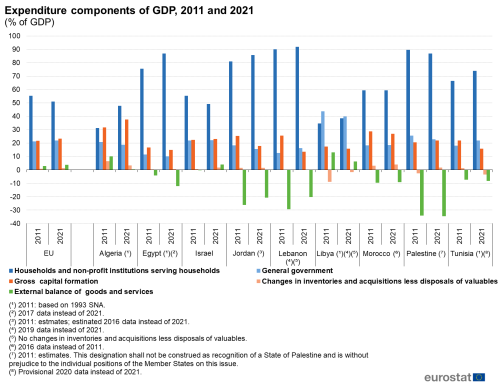
(% of GDP)
Source: Eurostat (nama_10_gdp) and (enps_nama_10_gdp_ea)
Gross value added by economic activity
Analysis of the gross value added by economic activity is useful to illustrate the structure of an economy and its changes over time. The analysis is limited by the fact that the ‘services’ category itself contains a wide variety of activities, such as government, transport services, tourism and business services. The proportion of construction in an economy typically varies over the economic cycle, with the sector doing well in periods of high growth and often contracting during recessions. The data are illustrated in Figure 4.
The size of the agriculture, forestry and fisheries sector accounted for 13.4 % of the Moroccan economy in 2021, the largest share among the ENP-South countries on the basis of the most recent data available. The sector share was 12.6 % of gross output in the Algerian economy in 2021. Egypt’s agriculture, forestry and fisheries sector made up a similar 11.7 % of gross value added in 2017. Tunisia’s sector share in 2020 accounted for 11.1 % of its economy (provisional data).
The remaining ENP-South countries had much smaller shares in gross value added by the agricultural, forestry and fisheries sector: the sector accounted for an estimated 6.0 % of gross value added in Palestine in 2021. Jordan had an estimated sector share of 5.2 % in 2016. In Lebanon, the sector share was 3.2 % in 2019. Israel had a sector share of 1.4 % in 2021. Libya had a sector share of 1.2 % in 2011; no data was available for 2021. The EU had a sector share of 1.8 % for agricultural, forestry and fisheries in 2021.
Unsurprisingly, the ENP-South countries with the largest shares of the industry sector in GDP are those with major hydrocarbon production: oil and natural gas. In Libya, this sector had a 65.0 % share of gross value added in 2011; 2021 data is not available. Algeria had a 28.9 % industry sector share of gross value added in 2021, down from 43.0 % in 2011. A significant share of gross value added was accounted for by industry also in Egypt, at 26.3 % (2017 data); in Jordan, 24.6 % (2016 data); in Morocco, 22.8 %; and in Tunisia, 19.6 %.
A group of ENP-South economies had a lower share of industry in gross value added. The share of industry in Palestine’s gross value added was 12.0 % in 2021. Israel’s share of industry in gross value added was 11.2 % in 2021. Lebanon’s industry share was 10.8 % in 2019. In comparison, the EU had a share of industry in gross value added of 20.0 % in 2021.
The overall services sector is made up of a wide, disparate range of sub-sectors. The highest share of services in gross value added in the ENP-South countries, on the basis of available data, was recorded at 83.2 % in Lebanon (2019 data). Israel, at 81.6 %, and Palestine, at 77.4 %, also had high services sector shares in 2021. Jordan, at 67.0 % (2016 data); Tunisia, at 65.0 % (provisional 2020 data); Morocco, at 57.5 % in 2021; and Egypt, at 56.3 % 2017, were intermediate cases. The share of services in Algeria in 2021, at 46.4 %, was lower. Libya had the lowest share of services among the ENP-South economies, at 30.8 % in 2011. There is no data for Libya for 2021. In the EU, the share of services in gross value added was 72.7 % in 2021.
Structural change in each economy can be seen by looking at the largest sector change in the period. Algeria saw a major reduction in its industry sector share of gross value added of -14.1 percentage points (pp) between 2011 and 2021. The share of output of all other sectors increased in compensation, the most significant being a 7.7pp increase in the share of services. The share of industry also decreased in Tunisia from 2011 to 2020, by -7.1pp, while the share of its services sector grew in compensation by 5.5pp. Egypt saw an increase in the share of the services sector of 6.8pp over 2011-2017, largely at the expense of industry, which declined by -5.1pp. Similarly, the share of services in Palestine increased by 6.7pp from 2011 (estimated) to 2021. The largest decrease was noted in its construction sector, at -3.1pp. The growth of the share of the services sector in Israel, at 4.1pp, was matched by a -3.9pp decline in the share of industry over 2011-2021. Other ENP-South countries, as well as the EU, did not show significant structural change during the period in question.
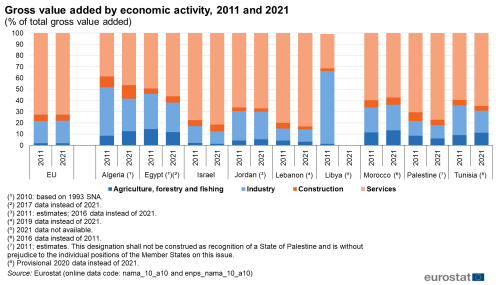
(% of total gross value added)
Source: Eurostat (nama_10_a10) and (enps_nama_10_a10)
Index of consumer prices
A consumer price index measures changes in the prices of a representative set of goods and services consumed by households. It is an important measure of inflation. In the European Union, the harmonised index of consumer prices provides a consumer price index that is directly comparable between the EU Member States.
Annual changes in the European Neighbourhood Policy–South countries’ national consumer price indices and the EU Harmonised index of consumer prices are shown in Table 2 for 2011-2022, providing the latest available data for each country. Over this period, the path of consumer price changes varied considerably between the countries.
Libya recorded rapid inflation in the two years that it reported data, 2017 and 2018, with increases in the CPI of 25.8 % and 13.2 %, respectively. Egypt saw consumer prices rising rapidly over the period 2011-2019, with average annual inflation at 12.7 %. Inflation was particularly strong during 2016-2018, peaking at 29.5 % in 2017. In 2019, the most recent year available, consumer prices rose by 9.2 %.
The path of consumer price rises in Lebanon has been a rollercoaster over the period 2011-2020. The CPI increased by 84.9 % in 2020, the latest data available. In 2015, measured consumer prices fell by -3.8 %. Excluding the 2020 figure, the greatest increase in the CPI was recorded in 2012 at 6.6 %. The annual average increase over 2011-2020 was 11.2 %; ignoring the very high rate of 2020, the annual average increase over 2011-2019 was 3.0 %. Consumer price rises in Tunisia averaged 5.6 % over the period 2011-2022, with inflation ranging from 3.5 % in 2011 to their highest point of 8.3 % in 2022.
During the period 2011-2022, Algeria’s prices rose most rapidly in 2022 (January-August data), at 9.6 %, and rose at their most moderate pace in 2019, at 2.0 %. The annual average increase in the CPI over the period was 5.2 %. In Jordan, data is available for 2011-2021. Prices rose by a maximum of 4.8 % in 2013 and fell by -0.9 % in 2015, which was Jordan's largest decline within the period. The most recent data is for 2021, when the CPI rose by 1.3 %. The annual average change in its CPI over 2011-2021 was 2.3 %.
In Palestine, changes in consumer prices were generally moderate over the period 2011-2021. The annual average change was 1.1 %. Data for some years is estimated. The peak rise in prices occurred in 2011 at 2.9 %. There was a slight fall in consumer prices of -0.7 % in 2020. Inflation in 2021 was 1.2 %. In Morocco, prices rose by 1.9 % in both 2013 and 2018, their fastest pace during the period 2011-2021; and by 0.2 % in 2019, their slowest pace. In 2021, the CPI rose by 1.4 %. The average annual change over the period was 1.1 %.
Israel’s highest point for consumer price rises over the period 2011-2021 was in 2011, at 3.5 %. Its low points occurred in 2015 and 2020, with falls of -0.6 %. In 2021, prices rose by 1.5 %. The annual average increase in the CPI was 0.8 %.
In the EU, consumer prices rose by 9.2 % in 2022, by far their fastest pace over the period 2011-2022. The smallest price rise was recorded in 2015, at 0.1 %. The annual average price change over this period was 2.1 %.
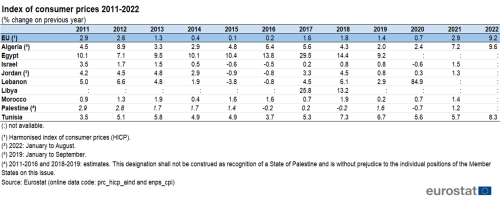
(% change on previous year)
Source: Eurostat (prc_hicp_aind) and (enps_cpi)
Balance of payments
The current account of the balance of payments represents transactions with the rest of the world concerning merchandise, services, income and other current transfers. It is normal for countries that are very fast growing to run negative balances, which represent borrowing from the rest of the world. Developed countries often run surpluses, which represent building up assets in the rest of the world. A country’s balance of payments deficit that is greater in magnitude than the growth in its nominal GDP increases its external debt relative to GDP. Large enough deficits can lead to severe financial difficulties. Data for the European Neighbourhood Policy–South countries and the EU are illustrated by Figure 5.
Lebanon recorded its smallest balance of payments deficit as a percentage of GDP over the period 2011-2019 in 2011 at -12.8 %. The greatest magnitude of the deficit occurred in 2013 at -26.4 % of GDP. In 2019, the deficit was -21.2 % of GDP. Over the period, the average deficit was -21.4 % of GDP.
The balance of payments deficit of Palestine was continual and substantial over the period 2011-2021 (data estimated). In 2021, the deficit was at its smallest for the period, at -9.3 % of GDP. It was at its largest in 2011, at -15.8 % of GDP. The average deficit over the period was -13.3 % of GDP.
Data for Jordan’s current account deficit is only available for 2011, when it was -9.6 % of GDP, and for 2012, when it had enlarged to -15.0 %. Tunisia’s deficit in 2020, the most recent year for which data is available, was -6.1 % of GDP, its smallest for the period. The deficit was at its greatest magnitude at -11.9 % of GDP in 2018. The average deficit over the period 2011-2020 was -9.0 % of GDP.
Data for the balance of payments deficit of Morocco is available from 2014-2021. Values ranged from -5.5 % of GDP in 2014 to -1.2 % of GDP in 2020, the smallest magnitude of the period. The average deficit was -3.3 % of GDP. The 2021 figure was -2.3 %. Data for Egypt is available for 2011-2013. In 2012, its payments deficit was -3.5 % of GDP; in 2013, -1.8 %.
Algeria ran a payments surplus from 2011 to 2013, peaking at 8.9 % of GDP in 2011. The payments situation then deteriorated to a deficit of -16.4 % of GDP in both 2015 and 2016. Deficits have since been moderate: the most recent figure is a deficit of -2.8 % of GDP in 2021. The average for the period was a deficit of -6.4 % of GDP.
Israel has run a payments surplus every year over the period 2011-2021, the smallest of which was 0.4 % of GDP in 2012 and the largest 5.3 % in 2015. The 2021 value was 4.6 % of GDP, with an average surplus over the period of 3.5 %. There is no data for Libya.
The EU’s payments surplus had its minimum value in 2011, at 0.6 % of GDP. Its maximum was recorded in 2016 at 3.2 % and its most recent value was 2.6 % of GDP in 2021. The average external surplus was 2.4 %.
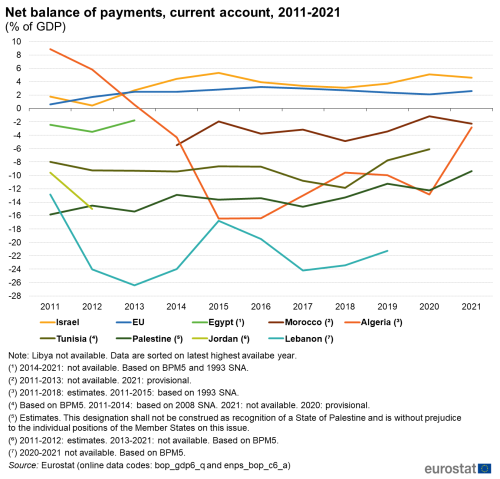
(% of GDP)
Source: Eurostat (bop_gdp6_q) and (enps_bop_c6_a)
Foreign direct investment
Foreign direct investment (FDI) represents a lasting interest in an enterprise operating in another economy and implies the existence of a long-term relationship between the direct investor and the recipient enterprise. It forms a part of the financial account of the balance of payments. Inflows represent investment in the economy; outflows represent investment by the economy in the rest of the world. Negative values represent disinvestment. Countries that attract considerable inward investment are often themselves investors in other countries. The data can change substantially from one year to the next, reflecting major investments in individual years. Figure 6 shows outward and inward inflows of foreign direct investment for ENP-South countries for 2011 and 2021.
Israel almost tripled its net inward investment from 2011 to 2021 (estimated data), which was by far the largest in the region in 2021. Morocco saw a marginal decrease in its inward investment between 2011 and 2021 (provisional data). Tunisia, Algeria and Lebanon all saw their inward investment flows decline, substantially so for the last two.
Israel’s outward foreign direct investment also substantially increased between 2011 and 2021 (estimated). In 2011, its outward direct investment had been almost as large as its inward flow; in 2021, Israel’s inward direct investment was more than twice the value of its outward flow. From a much lower base, Morocco’s outward flows tripled between 2011 and 2021 (provisional data). Tunisia’s outward flows diminished substantially from 2011 to 2021.
Algeria’s outward direct investment in 2011 was almost exactly matched by its 2021 disinvestment. Lebanon had negative flows of outward FDI in both 2011 and 2021. These represent disinvestment, which occurs when previous investments are withdrawn from the foreign enterprises, funds flow back from the foreign company to the parent company, or negative earnings are reinvested. Since the negative flows were smaller in 2021 than in 2011, the amount of disinvestment decreased.
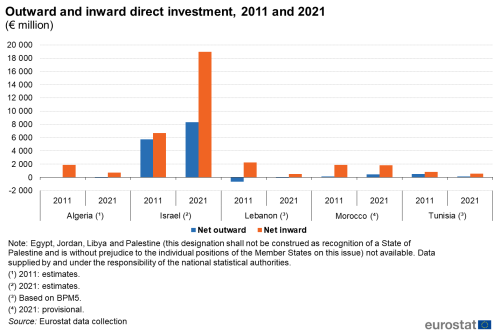
(€ million)
Source: Eurostat (bop_fdi_flow_r2) and (bop_fdi6_flow) and Eurostat data collection
Source data for tables and graphs
Data sources
The data for ENP-South countries are supplied by and under the responsibility of the national statistical authorities of each country on a voluntary basis. The data that are presented in this article result from an annual data collection cycle that has been established by Eurostat. No recent data are available from Syria. These statistics are available free-of-charge on Eurostat’s website, together with a range of different indicators covering most socio-economic areas.
Tables in this article use the following notation:
| Value in italics | data value is forecasted, provisional or estimated and is therefore likely to change; |
| : | not available, confidential or unreliable value; |
| – | not applicable. |
Context
Indicators derived from national accounts provide a picture of the economic situation; they are widely used for analysis and forecasting, as well as policymaking. Statistics on prices and finance illustrate the macroeconomic environment, in particular inflation and government and external payments deficits or surpluses, and so provide the framework for government policy decisions. Foreign direct investment statistics provide a measure of the attractiveness of a country as an investment destination.
The global financial and economic crisis reinforced the need to develop more robust government statistics in order to improve the surveillance and monitoring of financial systems and the impact that the crisis may have on economies, while also providing additional valuable information to support economic initiatives geared towards recovery. The use of internationally accepted concepts and definitions permits an analysis of different economies, such as the interdependencies between the economies of the EU Member States, or a comparison between the EU and non-member countries.
Within the EU, multilateral economic surveillance was introduced through the stability and growth pact, which provides for the coordination of fiscal policies. Economic and financial statistics have become one of the cornerstones of governance at a global and European level, for example, to analyse national economies during the global financial and economic crisis or to put in place EU initiatives such as the European semester, designed to promote discussions concerning economic and budgetary priorities, or the macroeconomic imbalance procedures (MIP).
The European Neighbourhood Policy (ENP), launched in 2003 and developed throughout 2004, supports and fosters stability, security and prosperity in the EU’s neighbourhood. The ENP was revised in 2015. The main principles of the revised policy are a tailored approach to partner countries; flexibility; joint ownership; greater involvement of EU member states and shared responsibility. The ENP aims to deepen engagement with civil society and social partners. It offers partner countries greater access to the EU's market and regulatory framework, standards and internal agencies and programmes.
The Joint Communication on Renewed Partnership with the Southern Neighbourhood – A new Agenda for the Mediterranean, accompanied by an Economic and Investment Plan for the Southern neighbours, of 9 February 2021 further guides cooperation with the ENP-South countries.
The main objective of Euro-Mediterranean cooperation in statistics is to enable the production and dissemination of reliable and comparable data, in line with European and international norms and standards.
Reliable and comparable data are essential for evidence-based decision-making. They are needed to monitor the implementation of the agreements between the EU and the ENP-South countries, the impact of policy interventions and the reaching of the Sustainable Development Goals (SDGs).
The EU has been supporting statistical capacity building in the region for a number of years through bilateral and regional capacity-building activities. This takes the form of technical assistance to partner countries’ national statistical authorities through targeted assistance programmes, such as the MEDSTAT programme and activities such as training courses, working groups and workshops, exchange of best practice and the transfer of statistical know-how. Additional information on the policy context of the ENP is provided here.
Notes
- ↑ This designation shall not be construed as recognition of a State of Palestine and is without prejudice to the individual positions of the Member States on this issue.
Direct access to
Books
Factsheets
- Statistics for a green future — factsheets on European Neighbourhood policy-South Countries — 2022 edition
- Basic figures on the European Neighbourhood Policy-South countries — 2022 edition
- Basic figures on the European Neighbourhood Policy-South countries — 2021 edition
Leaflets
- Basic figures on the European Neighbourhood Policy — South countries — 2020 edition
- Basic figures on the European Neighbourhood Policy — South countries — 2019 edition
- Basic figures on the European Neighbourhood Policy — South countries — 2018 edition
- Basic figures on the European Neighbourhood Policy — South countries — 2016 edition
- Basic figures on the European Neighbourhood Policy — South countries — 2015 edition
- International trade in goods for the European neighbourhood policy-South countries — 2018 edition
Factsheets
- Economy and finance (enps_ecf)
- National accounts (enps_na)
- Deficit/surplus and debt (enps_gov)
- Consumer price index (enps_cp)
- Balance of payments (enps_bop)
- Main GDP aggregates (nama_10_ma)
- Government finance statistics (EDP and ESA2010) (gov_gfs10)
- Balance of payments - International transactions (BPM6) (bop_6)
- Balance of payments statistics and international investment positions (BPM6) (bop_q6)
- European Union and euro area balance of payments - quarterly data (BPM6) (bop_eu6_q)
- Balance of payments statistics and international investment positions (BPM6) (bop_q6)
- European Union direct investments (BPM6) (bop_fdi6)
- EU direct investment flows, breakdown by partner country and economic activity (NACE Rev. 2) (bop_fdi_flow_r2)
- Southern European Neighbourhood Policy countries (ENP-South) (enps) (ESMS metadata file — enps_esms)